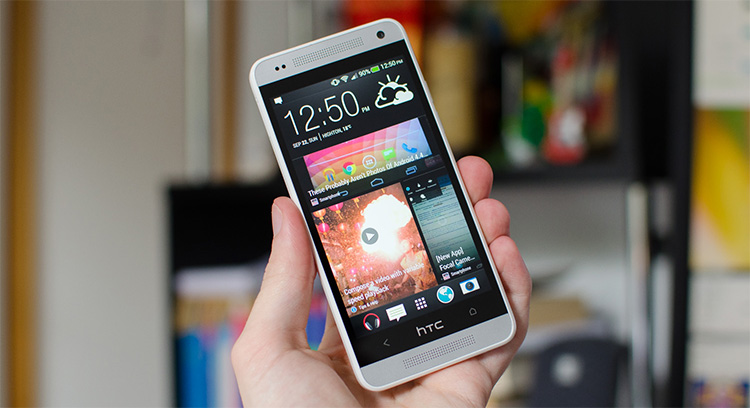Performance
Keeping with the theme of a mid-to-high end phone, the HTC One mini features a Qualcomm Snapdragon 400 MSM8930AA SoC. The SoC is Qualcomm's mid-range offering, packing a 1.4 GHz dual-core Krait 300 CPU, Adreno 305 GPU, dual-band Wi-Fi, Bluetooth 4.0 and HSPA/LTE radios. 1 GB of LPDDR2 RAM is also included, alongside 16 GB of internal storage without a microSD card slot.
CPU performance around the operating system is very good - lag free like you would expect from modern day Android phones - although it's not as speedy as systems powered by high-end chips such as Qualcomm's quad-core Snapdragon 600 or Samsung's Exynos 5 Octa. The One mini is a capable multi-tasker, switching apps very quickly, but not instantly. HTC's UI appears to have no adverse effect on system performance, despite it being a relatively heavy skin, which is fantastic.
Web browsing performance is acceptable, but the inclusion of only two cores in the SoC does have an impact on performance in some situations. Responsive mobile websites are fairly speedy, although when you dive in to some code-heavy desktop websites, or when you're using multiple tabs, expect the phone to experience slight slowdowns.
I tried a range of the latest games on the HTC One mini, and the Adreno 305 is a capable graphics chip, suited to a large range of games. I've had the most experience with this GPU in mid-to-low range Windows Phones (which use the Snapdragon S4 MSM8227), where it's more than capable of rendering to WVGA displays. With that said, the One mini features a 720p display, so the GPU has to render 140% more pixels, which understandably causes a performance hit.
The performance hit is only really noticeable in intensive 3D titles, such as Modern Combat 4 and Grand Theft Auto III. Where those two titles run at around 60 frames per second on Qualcomm's higher-end Snapdragon chips (and a large portion of last-generation's Snapdragon S4 chips), I did experience lag on the One mini. The aforementioned games are playable, but occasional stuttering can inhibit gameplay from time to time. If you just plan on using your smartphone for Angry Birds, Candy Crush and Temple Run, the Adreno 305 will give you no issues.
The HTC One mini is available in two models, one with and one without LTE. Even if you only have access to the HSPA model, I found no issues with the wireless performance of the device, even in low signal areas. Aside from cellular radios, the One mini also features dual-band Wi-Fi, Bluetooth 4.0 and A-GPS, although there's no NFC. A lack of NFC isn't a huge issue when the range of uses for the feature is limited, and it's likely HTC removed it for cost reasons.
Without a microSD card slot, the HTC One mini is capped at 16 GB of internal storage, with around 12 GB of that accessible to the user. While this is an acceptable mount of storage for those who want to install a few apps and perhaps chuck a few songs on their device, it's not really enough to use the One mini as a portable media player. I've seen unibody designs that include a microSD card slot (the Nokia Lumia 720 is one example), so I know it's possible to have expandable storage with designs like the HTC One mini, but I'm disappointed HTC opted for a fixed storage solution for this device.
However, one aspect of the HTC One and One mini that continues to impress is BoomSound and Beats Audio. BoomSound is HTC's marketing term for the dual front-facing speakers powered by a dedicated amplifier, and the results are amazing. The set of speakers used on the One/One mini are easily the best I've heard on a smartphone, providing loud audio with reasonable quality, and the inclusion of two speakers in a stereo setup helps while gaming and watching videos.
I still maintain that Beats Audio enhancement is the only software-side audio enhancer that actually makes music sound better through headphones. Beats provides an extra level of clarity and slight bass boosting that simply makes audio sound better than when the feature is disabled. Thanks to the feature, there is no doubting that you'll enjoy the HTC One mini as a music/audio player.
In terms of the phone's battery, we're seeing a reduction in capacity from 8.8 Wh in the HTC One to 6.9 Wh, however the smaller display and more power efficient SoC should keep the battery life roughly the same. In my usage I found the battery life to be adequate for a day's usage, tending towards being a little bit short if you're using the device a reasonable amount. CPU intensive tasks and a lot of browsing on LTE networks can drain the battery quite quickly, as you would expect, so you might have to moderate your usage to prevent the phone dying prematurely.
The capabilities of the Snapdragon 400 remind me of the last generation of dual-core phones; that's not necessarily a bad thing, but it keeps this phone from cementing itself as a perfect smaller-sized Android device. At the price that HTC is selling this handset ($500), I would have liked to see higher end parts such as the Snapdragon 600 on-board, with HTC marketing the device as a smaller, but equally powerful alternative to the HTC One. This may have cannibalized One sales, but it would have really established the handset as a 4.3-inch winner.




